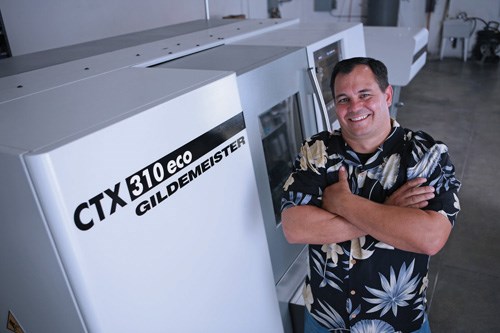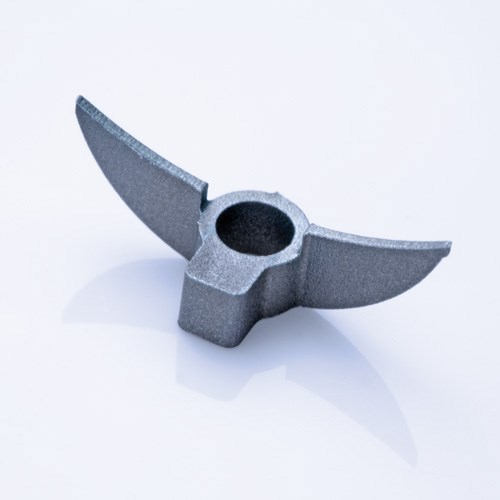Turn-Mill Turns Flexibility From Vision To Reality
A change in focus to lower-volume jobs led this manufacturer to sell its multi-axis screw machine and seek a new, flexible process to avoid tying up its traditional mills and lathes. DMG’s CTX 310ECO V3 turn-mill has helped the shop improve productivity and part quality while reducing labor costs.
Share



Achieving and maintaining maximum flexibility is often cited as a strategy employed by successful machine shops to stay ahead of the curve. American Optisurgical, a manufacturer of ophthalmic instruments in Lake Forest, California, is no exception. When changes in the industry forced the company to alter its focus toward lower-quantity jobs, it sought to replace its multiple-machine process with a more efficient manufacturing method. DMG’s CTX 310 ECO V3 turn-mill with live tools and a C axis enabled the shop to operate with less labor and improved productivity and part quality in a lights-out environment.
Founded in 1992, American Optisurgical focuses primarily on equipment for cataract eye surgery, although it also performs contract machining for a variety of industries to fill out extra capacity. Components and accessories for phacoemulsification instruments, which doctors use to extract cataracts from patients’ eyes, comprise the bulk of the company’s products. An example of one such component is a phaco tip, a small titanium needle that is inserted into a minute surgical incision in the eye. The tip vibrates between 20,000 and 40,000 times per second to emulsify the cataract. As it is emulsified, the cataract is sucked through a small hole in the phaco tip.
In addition to manufacturing work, the company is heavily involved in the service and repair of ophthalmic components. Many of these surgical instruments incorporate internal parts that are custom-built by the OEM, so replacements can’t be bought off-shelf. To efficiently handle large volumes of these components, the shop invested in a multi-axis screw machine. However, within a few years, the company faced a precipitous drop in part volume on these jobs, and the screw machine became impractical. "Some of the products we were servicing at that time have gone away," explains Tate Parham, director of engineering. "The main company that produces those devices has changed its way of doing things and is no longer making or supporting them."
To make up for the lost capacity and keep the screw machine busy, the company increasingly began to take on contract work. But lengthy setup and changeover times made this method inefficient for the low volumes characteristic of these jobs, too. "We knew the screw machine was geared toward high-volume runs," Mr. Parham says. "Still, we were led to believe that this particular machine would be easy to retool, to switch over, and it wasn’t as easy as presented."
While the screw machine sat idle, the shop increasingly turned to its traditional lathes and mills. After turning operations, ophthalmic components were moved to a mill for machining features such as wrench flats and cross holes. This process was far from ideal—moving parts from machine to machine was both labor and cost intensive, and multiple clampings increased the risk of error. Also, moving work previously done on the screw machine caused a bottleneck on the mills and lathes, which the shop used for both prototyping and an ever-increasing number of contract jobs.
"I needed to increase productivity or increase capacity, and I didn’t want to buy another lathe and still have to move parts between a mill and a lathe," Mr. Parham says. "I looked at a machining center with a Y axis and even a subspindle, but it was more complex than what I needed. I thought simply adding a mill step with live tooling for milling cross holes, shaft keys, slots and other features on the part before it comes off the machine would be enough to increase productivity."
With this in mind, the company sold the screw machine and began to evaluate various models of turn-mill machines. In addition to performing as many operations as possible on one platform, the machine would need capability for lights-out production. Specifically, Mr. Parham wanted a bar feeder and a large enough parts bin to enable unattended runs of at least 24 hours.
DMG’s CTX 310 ECO V3 fit the bill. Mr. Parham says the machine provides the flexibility and versatility the company needs without the complexity of models with subspindles, Y axes or other such features. "We’ve found that the ECO is a very ergonomically correct machine," he says. "Everything is simple to get to and quick to change. It’s easy to operate, and it’s very user-friendly."
Many parts can now be machined complete in a single setup, and even those that can’t require significantly fewer machining steps, Mr. Parham says. This has also improved part quality by helping to avoid the runout and tolerance stackup errors that can result from multiple re-fixturings. And thanks to the machine’s VDI tooling and an S-20 collet in the spindle nose—both of which are easy to change out, Mr. Parham says—the machine can be quickly reconfigured for different jobs.
The turn-mill is also equipped with the automation features Mr. Parham desired. An automatic bar loader allows it to run continuously throughout the day, whereas the previous process required an operator to change the bar in a lathe or move a part to a mill every 45 minutes or so, he says. With capacity for 12 cutters (six driven and six stationary), the machine’s tool turret also represents a significant improvement compared with his standard lathes, which accommodate only 10. "When you’re down to the last tool on those lathes, sometimes you have to sacrifice a tool for a needed operation, whether that’s drilling, tapping, turning, grooving or a number of other necessary processes," Mr. Parham explains.
Mr. Parham also credits DMG for working with him to put together "a great deal" on a machine with many of what he calls "high-end" features. "It’s a true slant bed, which is a plus, and it has cylindrical roller bearings, which is another plus," he says. In addition to improved chip evacuation, Mr. Parham says the machine’s slant-bed design provides a shorter distance between the X- and Z-axis linear guides compared to other configurations. In contrast, having greater distance between these guides could reduce rigidity, he explains. He adds that he prefers cylindrical bearings for a similar reason—with greater contact area than ball bearings, cylindrically shaped bearings can improve rigidity.
Another notable feature is the machine’s Siemens 810D Powerline CNC with ShopTurn software. Mr. Parham prefers conversational programming on the shop floor, and this software is intuitive and easy to work with, he says. The software also provides a full simulation of the cutting process to help avoid crashes and other problems. Moreover, the operator can program the next part while the machine runs.
Mr. Parham estimates that compared with either previous manufacturing method—the screw machine or multiple lathes and mills—operators spend approximately 75 percent less time "babysitting." That is, less time monitoring processes, less time setting up and less time loading and unloading parts. "The ECO is more versatile and easier to change over, and for our smaller-quantity runs, it is a much better fit," he concludes.
Related Content
Digitalization and Done-In-One Reign Supreme at BIEMH 2024
European manufacturers may have a different balance of markets than their U.S. counterparts, but the practical challenges they must overcome are often similar — as are the solutions.
Read MoreView From My Shop: The Challenge of a One-Man Machine Shop
Mason Montalvo took up the challenge of starting his own shop running manual machine tools to produce complex parts.
Read MoreMazak Achieves Production Milestone, Announces Plans to Open New Technical Center
Mazak Corporation celebrates the completion of its 40,000th machine at the Mazak iSmart Factory in Florence, Kentucky, showcasing advanced manufacturing and digital integration.
Read MoreCustom Workholding Shaves Days From Medical Part Setup Times
Custom workholding enabled Resolve Surgical Technologies to place all sizes of one trauma part onto a single machine — and cut days from the setup times.
Read MoreRead Next
OEM Tour Video: Lean Manufacturing for Measurement and Metrology
How can a facility that requires manual work for some long-standing parts be made more efficient? Join us as we look inside The L. S. Starrett Company’s headquarters in Athol, Massachusetts, and see how this long-established OEM is updating its processes.
Read More




























